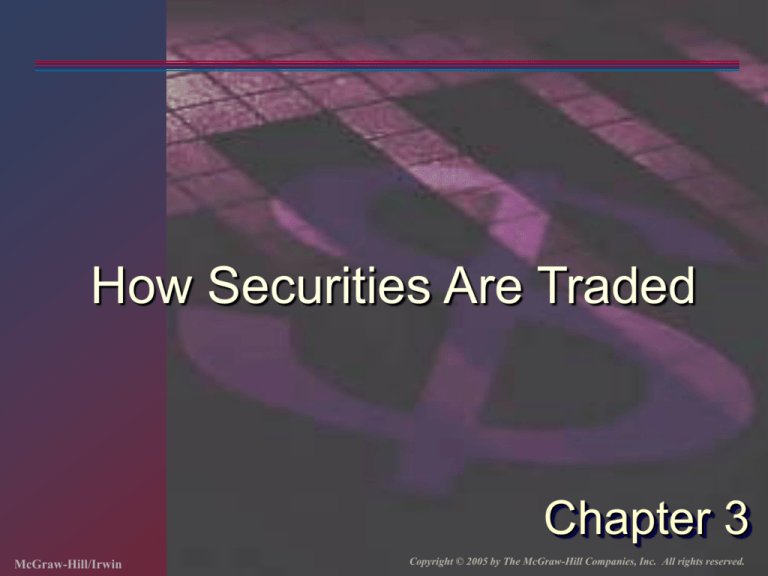
How Securities Are Traded
Chapter 3
McGraw-Hill/Irwin
Copyright © 2005 by The McGraw-Hill Companies, Inc. All rights reserved.
Primary vs. Secondary Security Sales
Primary
New issue - Key factor: issuer receives
the proceeds from the sale.
Secondary
Existing owner sells to another party.
Issuing firm doesn’t receive proceeds and
is not directly involved.
3-2
Investment Banking Arrangements
Bringing new securities to market
Underwritten vs. Best Efforts
Underwritten: firm commitment on
proceeds to the issuing firm.
Best Efforts: no firm commitment.
Negotiated vs. Competitive Bid
Negotiated: issuing firm negotiates terms
with investment banker.
Competitive bid: issuer structures the
offering and secures bids.
3-3
Public Offerings
Public offerings: registered with the
SEC and sale is made to the investing
public.
Shelf registration (Rule 415, since 1982)
Initial Public Offerings (IPOs)
Evidence of underpricing (see page 69)
Performance (see page 71)
3-4
IPOs slow down in 2006, but deals survive
By Steve Gelsi, MarketWatch
Last Update: 11:56 AM ET Aug 15, 2006
NEW YORK (MarketWatch) -- With a batch of scuttled IPOs this
summer adding to the void, the market for initial public offerings
has slowed down this year in the face of rising interest rates,
record oil prices and geopolitical jitters.
A total of 137 U.S. initial public offerings have priced in 2006 for
proceeds of $26.3 billion, according to Dealogic.
That's about 10% less in number than the 153 IPOs priced in the yearago period for proceeds of $28.3 billion.
Forty-two IPOs have been withdrawn or postponed so far in 2006, a
17% increase compared to this time in 2005, when 36 deals had been
withdrawn or postponed.
IPO investors have been particularly cool to the tech sector, once the
darling of the IPO market, after the lackluster debut of Vonage (VG :
vonage hldgs corp com
Or it might be a few high-profile IPO letdowns like telephone-broadband
company Vonage (VG: 7.52, +0.44, +6.2%) that are souring some
investors. Vonage, which Holmes calls a bold play that turned out to be
a disaster, was a venture-backed dud. It priced at $17 on May 24, and
subsequently closed down more than 12% on its first day of trading. It's
now near $7. (from yahoo.smartmoney
3-5
Private Placements
Private placement: sale to a limited
number of sophisticated investors not
requiring the protection of registration.
Dominated by institutions.
Very active market for debt securities.
Not active for stock offerings.
3-6
Organization of Secondary Markets
Organized exchanges
OTC market
Third market
Fourth market
3-7
Organized Exchanges
A physical location
Auction markets with centralized order
flow.
Dealership function: can be competitive
or assigned by the exchange
(Specialists).
Securities: stock, futures contracts,
options, and to a lesser extent, bonds.
Examples: NYSE (about 85% of exchange
trading in US), AMEX (has ETF’s exchange
traded funds), Regionals, CBOE.
3-8
Role of the Specialist
Role of the specialist is to provide “a fair and
orderly market – i.e. “makes a market”
The specialist must be willing to buy or sell at
all times (post quotes) – provides price
continuity
Has monopoly on his or her stocks
Maintains the “limit order book”
May act as a broker (earns commissions) or a
dealer (earns spreads)
Participates in about ¼ of trading volume on
NYSE
3-9
OTC Market
Dealer market without centralized order
flow.
Nasdaq (formerly National Association of
Securities Dealers Automated Quotation
system) - the largest organized stock market
for OTC trading; information system for
individuals, brokers and dealers. Similar in
Dollar Volume to NYSE
Securities: stocks, bonds and some
derivatives.
Most secondary bonds transactions
3-10
Third Market
Trading of listed securities away from
the exchange.
Institutional market: to facilitate trades
of larger blocks of securities.
Involves services of dealers and brokers
3-11
Fourth Market
Historically was Institutions trading
directly with institutions
No middleman involved in the
transaction
Organized information and trading
systems
ECN (Electronic Communication
Network) – allows individuals to trade
directly with others.
3-12
International Market Structures
London Stock Exchange
Dealer market similar to NASDAQ
Stock Exchange Automated Quotation
Greater Anonymity
Tokyo Stock Exchange
No market making service (No specialist)
Sartori provides bookkeeping service
Feature a floor and electronic trading
Global Market Alliances –
Euronext from merger of Paris, Amsterdam &
Brussels
Co-listing in the future to allow 24 hour trading?
3-13
Costs of Trading
Commission: fee paid to broker for making
the transaction
Spread: cost of trading with dealer
Bid: price dealer will buy from you
Ask: price dealer will sell to you
Spread: ask - bid
Combination: on some trades both are paid
Paying for order flow – paying a broker a
rebate for directing trade to dealer (important
for “free trading”)
3-14
Types of Orders
Instructions to the brokers on how to
complete the order
Market – trade immediately at the best
price
Limit – place some conditions on the
price at which trade
Stop loss – sell if the stock fall to a
specified price – the order then becomes a
market order (protects downside).
Stop buy – buy if the price rises to a
specified price (protects short sales)
3-15
Margin Trading
Buying stocks on margin means taking out a
loan so you can buy more stock.
Short selling requires a margin deposit to
guarantee your position
Futures margin (to be discussed later) mean
depositing funds as surety for your trade
(similar to short selling stocks)
Buying stocks on margin leverages the gains
or losses!
Margin = Equity/(Stock Value)
= (Assets – Liabilities)/(Stock Value)
3-16
Stock Margin Trading
Maximum initial margin
Currently 50% (set by the Fed)
Maintenance margin
Minimum level the equity margin can fall
to. Determined by the exchange and/or
the brokerage house
Margin call
Daily marking to market (checking to see
you are in compliance)
If you fall short, you must correct the
situation or your position will be closed
3-17
Margin Trading - Initial Conditions
X Corp
$70
50%
Initial Margin
40%
Maintenance Margin
1000
Shares Purchased
Initial Position (Balance Sheet)
Stock $70,000 Borrowed
$35,000
Equity
$35,000
Assets = 70,000 Liabilities = 35,000
Margin = (70,000 – 35,000)/70,000
3-18
Margin Trading - Maintenance Margin
Stock price falls to $60 per share
New Position
Stock $60,000 Borrowed
$35,000
Equity
$25,000
Margin = (60,000 – 35,000)/60,000
Margin% = $25,000/$60,000 = 41.67%
3-19
Margin Trading - Margin Call
How far can the stock price fall before a
margin call?
Note: (1000P - Amount Borrowed) = Equity
(1000P - $35,000) / 1000P = 40%
solve for P
P = $58.33
3-20
Return on Margin Purchase Pt = $80, i=5%
hpr = (Vt – Vt-1 )/Vt-1
Vt-1 = Initial Investment = $35,000
Vt = Proceeds from closing position
= Sale of Stock – Repaying of Loan
= 80,000 – (1.05)*35,000
= 80,000 – 36,750 = 43,250
hpr = (43,250 – 35,000)/35,000 = 23.57%
Stock only return = (80-70)/70 = 14.29%
Note: 23.57% = 14.29% + 14.29% - 5%
3-21
Return on Margin Purchase Pt = $60, i=5%
hpr = (Vt – Vt-1 )/Vt-1
Vt-1 = Initial Investment = $35,000
Vt = Proceeds from closing position
= Sale of Stock – Repaying of Loan
= 60,000 – (1.05)*35,000
= 60,000 – 36,750 = 23,250
hpr = (23,250 – 35,000)/35,000 = -33.57%
Stock only return = (60-70)/70 = -14.29%
Note: -33.57% = -14.29% - 14.29% - 5%
3-22
Short Sales
Purpose: to profit from a decline in the price
of a stock or security.
Mechanics
Borrow stock through a dealer.
Sell it and deposit proceeds and margin in an
account.
Closing out the position: buy the stock and
return to the party from which it was
borrowed.
3-23
Short Sales News (WSJ)
Record Activity
In Short Selling
Hits the Nasdaq
Rise During Latest Month
Occurred Despite a Rally
In the Technology Sector
By PETER A. MCKAY
August 25, 2006; Page A12
Short-selling activity hit a record on the Nasdaq Stock Market
during the latest monthly period, despite a rally in the technology
sector.
For the period ended Aug. 15 , the number of short-selling
positions not yet closed out at the Nasdaq -- so-called short
interest -- rose 1.8% to 7,268,106,428 shares, from
7,139,899,294 shares in mid-July.
Marketwide, the short ratio, or number of days' average volume
represented by the outstanding short positions on the market,
fell to 4.0 from 4.1.
3-24
Short Sale - Initial Conditions
Z Corp
50%
30%
$100
100 Shares
Initial Margin
Maintenance Margin
Initial Price
Sale Proceeds $10,000 (Asset)
Margin & Equity
5,000 (Asset)
Stock Owed
10,000 (Liability)
(Also is the Stock Value)
Margin = (10,000 + 5000 – 10,000)/10,000
3-25
Short Sale - Maintenance Margin
Stock Price Rises to $110
Sale Proceeds
$10,000
Initial Margin
5,000
Stock Owed
11,000
Net Equity
4,000
Margin: (10,000 + 5000 – 11,000)/11,000
Margin % (4000/11000)
36%
3-26
Short Sale - Margin Call
How much can the stock price rise before a
margin call?
($15,000* - 100P) / (100P) = 30%
P = $115.38
* Initial margin plus sale proceeds
3-27
Regulation of Securities Markets
Government Regulation
Self-Regulation
Circuit Breakers
Insider Trading
ECNs and Fragmentation
3-28










